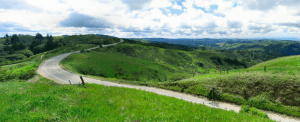
Clicking through, yet again, photographs of refugee families waiting in or trudging through European countries as winter falls, I feel remorse primarily because I’m not with them to lend a hand, but even more so because the actions of my country played a heavy hand in the series of events that led to their exodus.
Finishing Ta-Nehisi Coates’s book Between the World and Me, I realize painfully that even if consciously I do not consider myself racist, I nevertheless participate directly and personally in a society and series of decisions that reinforce the disenfranchisement of people of color in America. Even if I do not intend to erect the proverbial Wall, I am nevertheless a brick in it—this wall that divides people, this wall that makes it so that we are no longer with each other.
Careening along Interstate 280 at 75 miles per hour, I look out the window of a 3,300-pound vehicle of steel and plastic, at the now verdant Santa Cruz mountains and imagine the thousands of species of flora and fauna that I do not see, that I do not touch, and that truthfully I cannot even name because I am not with them, and have never been with them. Any reality that I could have engaged and enjoyed in those mountains is rendered meaningless, quite literally immaterial, by my entombment in a fast-moving shell of comfortable upholstery, artificial heat, and a traffic report on NPR.
We generally imagine incarnation as “to be a body,” in the sense that we are separate material manifestations among other material manifestations or surrounded by an environment. This illusion of being an active character against a passive backdrop is produced in our earliest years by watching cartoons of dynamic characters against static backgrounds and is cemented into our consciousness as we grow up in a civilization of cities where virtually every single thing—even the sidewalks beneath our feet—reinforce the illusion of being an actor, a body, on or in a setting.
We should go deeper: imagine incarnation as “to be body”—not among other bodies and things but rather with other bodies and things—not being on or in the world, but really with, indeed one with, the world—being the body of the world.
We get caught up in the sophisticated terms that have Latin or Greek as their origins, words like incarnation or empathy. But in the world as we live it, we find we use much simpler, more direct terms to express what we feel and are. When you love someone, do you find yourself telling her or him, “I wish we were empathizing”? You say rather, “I wish you were here” or “I want to be with you.” Greg Boyle, the very down-to-earth Jesuit priest who makes it his ministry to tend to gang members in Los Angeles, remarked upon a common platitude in some circles: “If you want peace, work for justice.” Boyle adds that you’ll have neither peace nor justice if you don’t have kinship. What is the point of talking and writing on and on about wishes for peace abroad or justice at home if we don’t actually spend our time—indeed our lives—with people, with the people who come to mind when we write, wish, or pray about peace and justice?
What do we mean by “with-ness,” and how does it bear upon our own incarnation?
When you see a large group of people dancing, it’s not difficult to detect who is really with the music. When people are swept away by songs they love and rhythms that animate them, you can see quite clearly that they are really with the song—everything else in their minds falls away and the two—song and dancer—become one.
Imagine walking a large dog out into an open expanse, perhaps a field or a beach, and you begin to run together, and the dog breaks into a gallop and you begin to laugh, barely able to keep up as its power pulls you along, hanging on to the leash. It’s clear how exhilarated this dog must be to sprint so quickly into the wind, nostrils flaring. At that moment of running and breathing so hard and laughing alongside this creature very different from yourself, you find yourself really relishing being with this animal and experiencing each other together swept away by joy and excitement.
Imagine now cradling this same dog, years later, in a veterinary clinic for the last time, while the veterinarian administers the euthanasia solution. In those last moments as the pet dies, you find yourself very strongly with the animal and at once very strongly with your own sorrow. This experience is no less an experience of incarnation; we incarnate into a world of all seasons: spring and autumn, youth and dying.
We witness our aging much more strongly in photographs of ourselves than in the mirror. In photographs we cannot turn our faces to different angles or primp. To what lengths will we go to resist the inexorable advance of age? Do we will to be with our own creatureliness, subject to change and decay?
My oldest son is far enough along the autism spectrum that in all likelihood he will not live independently and enjoy a “normal” life. Having an autistic child is at times like having a pebble in your shoe as you walk; at other times it’s like having lost a foot altogether. Being with (not simply around) a person whose mental hardware is fundamentally different from one’s own, and easily judged as broken, is a tremendous challenge, day after day, and sometimes night after night. Christ’s words in the Garden come to mind: “The spirit is willing but the flesh is weak” (Mark 14:38).
Christmas is an invitation to contemplate the Incarnation, as much our own and that of others as Christ’s. As we read in both Isaiah 7 and Matthew 1: “Therefore the Lord will give you a sign; the young woman, pregnant, will bear a son and shall name him Emmanuel, which means ‘God with us.’”
Incarnation is with-ness.
We can careen through the natural world by automobile or aircraft, recline leisurely before a digital news broadcast, pity the plight of different-looking people on the other side of the city or world, and continue merely to exist, comfortably.
Or we can live (not always comfortably)
and be physically present—
to song
to joy
to loss
to age
to people with different minds
to people with different skin
to people with no home
to the real world.
“And the Word became flesh and made his dwelling among us” (John 1:14).
We ourselves are called to incarnation.












